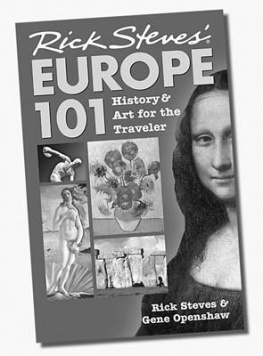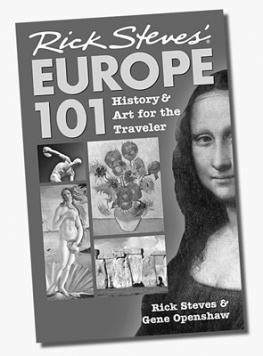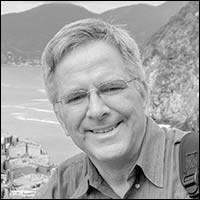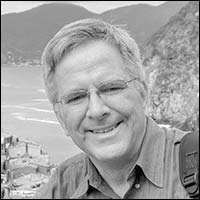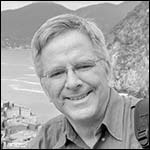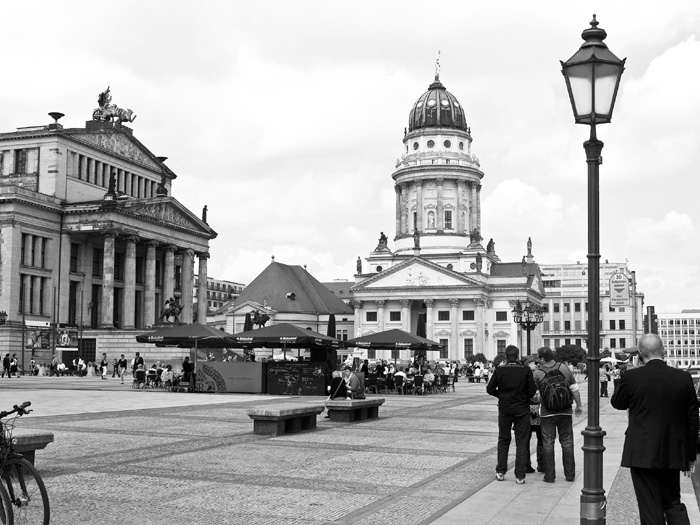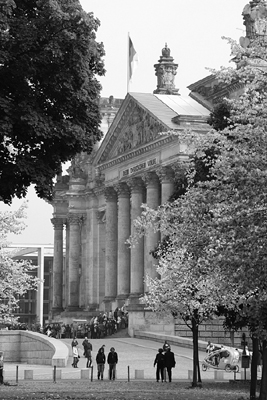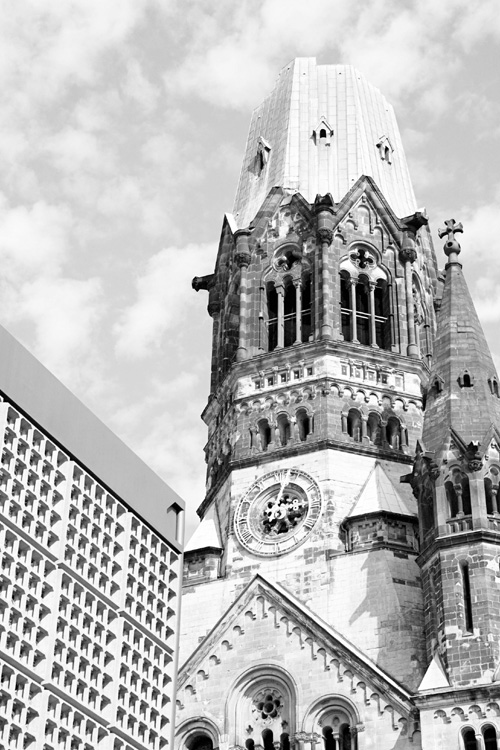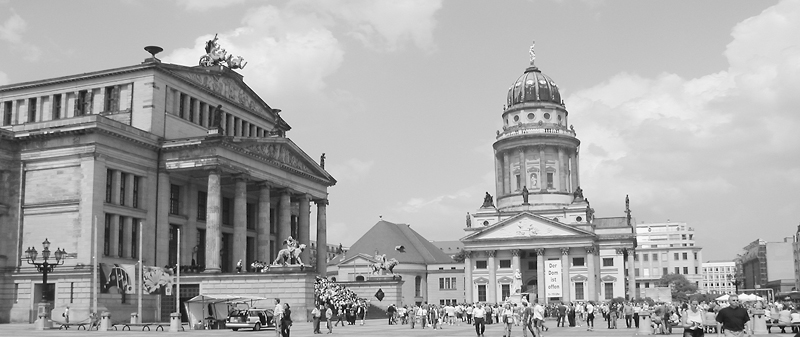Rick Steves
SNAPSHOT
Berlin
This Snapshot guide, excerpted from my guidebook Rick Steves Germany, introduces you to the resurgent German capital. Once divided, now reunited, vibrant Berlin is racing into the future and re-emerging as one of Europes leading cities. Walk under the Brandenburg Gate and stroll up the boulevard called Unter den Linden, pondering the layers of history beneath your feet. Relive the Cold War as you follow the course of the long-gone Berlin Wall, while towering cranes above you erect glittering new skyscrapers. Dip into art museums for a look at the Pergamon marbles and the famous bust of Queen Nefertiti. Take a day-trip to Frederick the Greats palaces and gardens in Potsdam or the sobering concentration camp memorial at Sachsenhausen.
Ive also included a pair of nearby cities to round out your look at eastern Germany. Dresdena glorious Baroque city of art, architecture, and culture, and home to some of the countrys best museumsis finally being rebuilt after its notorious World War II firebombing. And laid-back Grlitz, a glossy textbook of architectural styles, offers a taste of the multiethnic region of Silesia.
To help you have the best trip possible, Ive included the following topics in this book:
Planning Your Time, with advice on how to make the most of your limited time
Orientation, including tourist information (abbreviated as TI), tips on public transportation, local tour options, and helpful hints
Sights with ratings:
Dont miss
Try hard to see
Worthwhile if you can make it
No ratingWorth knowing about
Sleeping and Eating, with good-value recommendations in every price range
Connections, with tips on trains, buses, and driving
Practicalities, near the end of this book, has information on money, phoning, hotel reservations, transportation, and more, plus German survival phrases.
To travel smartly, read this little book in its entirety before you go. Its my hope that this guide will make your trip more meaningful and rewarding. Traveling like a temporary local, youll get the absolute most out of every mile, minute, and dollar.
Gute Reise!
Rick Steves
No tour of Germany is complete without a look at its historic and reunited capital. Over the last two decades, Berlin has been a construction zone. Standing on ripped-up tracks and under a canopy of cranes, visitors witnessed the rebirth of a great European capital. Although construction continues, today the once-divided city is thoroughly woven back together. Berlin has emerged as one of Europes top destinations: captivating, lively, fun-loving, all-around enjoyableand easy on the budget.
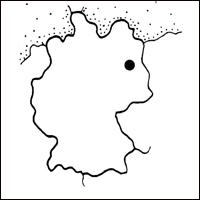
As you enjoy the thrill of walking over what was the Wall and through the well-patched Brandenburg Gate, its clear that history is not contained in some book, but is an exciting story of which we are a part. In Berlin, the fine line between history and current events is excitingly blurry. But even for non-historians, Berlin is a city of fine experiences. Explore the fun and funky neighborhoods emerging in the former East, packed with creative hipster eateries and boutiques trying to one-up each other. Go for a pedal or a cruise along the delightful Spree riverfront. In the citys world-class museums, stroll up the steps of a classical Greek temple amid rough-and-tumble ancient statuary, and peruse canvases by Drer, Rembrandt, and Vermeer. Nurse a stein of brew in a rollicking beer hall, or dive into a cheap Currywurst (arguably the most beloved food ever to come out of Berlin). On the outskirts of town, at Potsdam, glide like a swan through the opulent halls of an imperial palace, and ponder the darkest chapter of this nations history at the Sachsenhausen Concentration Camp Memorial.
Of course, Berlin is still largely defined by its tumultuous 20th century. The city was Hitlers capital during World War II, and in the postwar years, Berlin became the front line of a new global warone between Soviet-style communism and American-style capitalism. The East-West division was set in stone in 1961, when the East German government boxed in West Berlin with the Berlin Wall. The Wall stood for 28 years. In 1990, less than a year after the Wall fell, the two Germanysand the two Berlinsofficially became one. When the dust settled, Berliners from both sides of the once-divided city faced the monumental challenge of reunification.
Berliners joke that they dont need to travel anywhere because their citys always changing. Spin a postcard rack to see whats new. A 10-year-old guidebook on Berlin covers a different city. City planners have seized on the citys reunification and the return of the national government to make Berlin a great capital once again. When the Wall fell, the East was a decrepit wasteland and the West was a paragon of commerce and materialism. More than 20 years later, the roles are reversed: Its eastern Berlin where you feel the vibrant pulse of the city, while western Berlin seems like yesterdays news.
Today, Berlin is like the nuclear fuel rod of a great nation. Its so vibrant with youth, energy, and an anything-goes-and-anythings-possible buzz that Munich feels spent in comparison. Berlin is both extremely popular and surprisingly affordable. As a booming tourist attraction, Berlin now welcomes more visitors than Rome.
The History of Berlin
Berlin was a humble, marshy burgits name perhaps derived from an old Slavic word for swampuntil prince electors from the Hohenzollern dynasty made it their capital in the mid-15th century. Gradually their territory spread and strengthened, becoming the powerful Kingdom of Prussia in 1701. As the leading city of Prussia, Berlin dominated the northern Germanic worldboth militarily and culturallylong before there was a united Germany.
The only Hohenzollern ruler worth remembering was Frederick the Great (1712-1786). The ultimate enlightened despot, he was both a ruthless military tactician (he consolidated his kingdoms holdings, successfully invading Silesia and biting off a chunk of Poland) and a cultured lover of the arts (he actively invited artists, architects, and other thinkers to his lands). Old Fritz, as he was called, played the flute, spoke six languages, and counted Voltaire among his friends. Practical and cosmopolitan, Frederick cleverly invited groups to Prussia who were being persecuted for their Protestantism elsewhere in Europeincluding the French Huguenots and Dutch traders. Prussia became the beneficiary of these groups substantial wealth and know-how. Frederick the Great left Berlinand Prussiaa far more modern and enlightened place than he found it. Thanks largely to Frederick, Prussia was well-positioned to become a magnet of sorts for the German unification movement in the 19th century.



